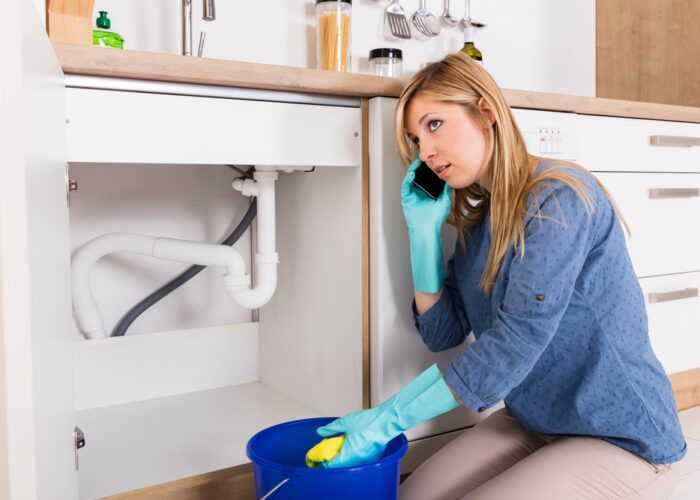
How to Tell if Your Water Is Leaking Slowly
Water leaks can be a homeowner’s nightmare, especially when they go unnoticed. While a sudden burst pipe or a visible pool of water is easy to spot, slow leaks can be more insidious. They often lurk behind walls, under floors, or within your plumbing system, gradually causing damage that can lead to costly repairs and even health hazards. Recognizing the subtle signs of a slow water leak is crucial in preventing extensive damage to your home.
Why Slow Water Leaks Are a Serious Concern
Slow water leaks may seem minor, but they can lead to significant problems over time. When water continuously seeps into building materials, it can cause them to deteriorate. Wood can rot, drywall can warp, and metal components can rust. Moreover, these leaks create the perfect environment for mold growth, which can pose serious health risks to you and your family.
The longer a slow leak goes undetected, the more extensive the damage becomes. What might start as a small repair can quickly escalate into a full-blown renovation. Also, mold can make your home uninhabitable until professional remediation is completed. Therefore, it’s vital to be vigilant and proactive in identifying any signs of slow water leaks.
Common Signs of Slow Water Leaks
Unexplained Increase in Water Bills
One of the first indicators of a slow water leak is an unexplained increase in your water bill. If your water usage has remained consistent, but your bill has suddenly spiked, it’s a red flag. A slow leak, though small, can waste hundreds of gallons of water over time, leading to higher utility costs. Compare your current water bill to previous months or years to identify any unusual trends.
Mold and Mildew Growth
Mold and mildew thrive in damp environments, making them a common consequence of slow leaks. If you notice mold or mildew forming in areas that are typically dry, such as walls, ceilings, or floors, water is likely leaking somewhere nearby. Mold can appear as black, green, or white spots and is often accompanied by a musty odor. If left untreated, mold can spread rapidly, contaminating large areas of your home.
Musty Odors
A persistent musty smell can indicate a slow water leak, even if mold or mildew isn’t visible. This odor is usually caused by water that has been sitting in one place for an extended period, allowing mold spores to proliferate. The smell might be most noticeable in confined areas like basements, crawl spaces, or attics, where ventilation is poor.
Stains and Discoloration
Water stains and discoloration on walls, ceilings, or floors are classic signs of a slow leak. These stains often appear yellowish-brown and may be accompanied by peeling paint or wallpaper. The location of the stain can give you a clue about where the leak might be coming from. For instance, if you notice a stain on the ceiling directly beneath a bathroom, the leak is likely originating from the bathroom plumbing.
Warped or Buckled Flooring
Water leaking under your floors can cause them to warp or buckle. This is particularly common with wooden floors, which expand when exposed to moisture. You might also notice that the floor feels spongy or soft in certain areas. If your flooring is carpeted, look for damp spots or areas where the carpet appears discolored.
Low Water Pressure
If your water pressure suddenly drops without any apparent reason, it could be due to a slow leak. Leaks in your plumbing system can reduce the amount of water that reaches your faucets and showerheads, leading to a noticeable decrease in water pressure. This issue may be more apparent when multiple fixtures are being used simultaneously.
Unusual Sounds
Water leaks can sometimes be detected by sound. If you hear dripping, gurgling, or hissing noises when no water is being used, it could indicate a leak. These sounds might be coming from within walls, under floors, or near appliances like dishwashers or washing machines.
Foundation Cracks
In some cases, a slow leak can cause your home’s foundation to crack. Water that seeps into the soil around your foundation can cause it to shift or settle unevenly, leading to cracks in the foundation. These cracks can allow even more water to enter your home, compounding the problem.
How to Confirm a Slow Water Leak
If you suspect that your water is leaking slowly, there are several steps you can take to confirm it:
Check Your Water Meter
One of the simplest ways to confirm a water leak is by checking your water meter. First, ensure that all water-using appliances and fixtures in your home are turned off. Then, locate your water meter and take a reading. Wait for one to two hours without using any water, and then take another reading. If the meter reading has changed, you likely have a leak.
Conduct a Dye Test for Toilets
Toilets are common sources of slow leaks, and if not addressed, they can waste a significant amount of water. To check for a toilet leak, add a few drops of food coloring to the tank and wait about 30 minutes. If the colored water appears in the toilet bowl without flushing, you have a leak.
Inspect Visible Plumbing
Take a walk around your home and inspect any visible plumbing for signs of leaks. Look for dripping faucets, wet spots under sinks, or rusted pipes. Don’t forget to check your outdoor plumbing, including hose bibs and irrigation systems.
Hire a Professional for a Leak Detection Test
If you’ve tried these methods and still can’t locate the leak, it’s time to call in a professional. Ahold of Mold Environmental offers expert leak detection services that can accurately pinpoint the source of a leak, even if it’s hidden behind walls or under floors. Our team uses advanced technology, such as thermal imaging and moisture meters, to detect leaks without causing unnecessary damage to your home.
The Risks of Ignoring a Slow Water Leak
Failing to address a slow water leak can seriously affect your home and your health. Here are some of the risks associated with ignoring a slow leak:
Structural Damage
As water continues to seep into your home’s structure, it can weaken the materials and compromise the integrity of your home. Over time, this can lead to sagging ceilings, bowing walls, and even foundation problems. Repairing structural damage is often expensive and time-consuming, making it crucial to catch leaks early.
Mold Growth
Mold thrives in damp environments, and a slow leak provides the perfect conditions for it to grow. Mold can spread quickly and contaminate large areas of your home, including walls, floors, and ceilings. In addition to the damage it causes to your property, mold can pose serious health risks, particularly for individuals with respiratory conditions or weakened immune systems.
Health Issues
Mold exposure can lead to a variety of health problems, including allergic reactions, asthma attacks, and respiratory infections. People with existing health conditions, such as asthma or allergies, are particularly vulnerable to the effects of mold exposure. In some cases, prolonged mold exposure can result in chronic respiratory issues or other long-term health problems.
Increased Repair Costs
The longer a slow leak goes undetected, the more extensive the damage becomes. What might start as a minor repair can quickly escalate into a costly renovation. In addition to repairing the leak itself, you may need to replace damaged materials, address mold growth, and restore the structural integrity of your home.
Preventing Slow Water Leaks
While it’s important to know how to tell if your water is leaking slowly, it’s equally important to take steps to prevent leaks from occurring in the first place. Here are some tips to help you protect your home from slow water leaks:
Regularly Inspect Your Plumbing
Make it a habit to inspect your plumbing regularly for signs of wear and tear. Look for rusted pipes, loose connections, and other potential issues that could lead to leaks. Addressing these problems early can help prevent more serious issues down the road.
Install a Leak Detection System
Consider installing a leak detection system in your home. These systems can monitor your plumbing for leaks and alert you to potential problems before they cause significant damage. Some systems can even shut off your water supply automatically if a leak is detected.
Maintain Your Home’s Gutters and Downspouts
Proper drainage is essential in preventing water damage to your home. Make sure your gutters and downspouts are clean and in good repair to prevent water from pooling around your foundation. This will help reduce the risk of leaks and water damage.
Address Small Leaks Promptly
If you notice a small leak, don’t ignore it. Even a minor drip can turn into a major problem if left unchecked. Address small leaks promptly to prevent them from becoming more serious issues.
Call Ahold of Mold Environmental for Professional Assistance
Slow water leaks can be challenging to detect and even more difficult to repair. If you suspect that your water is leaking slowly, it’s essential to take action immediately. Ahold of Mold Environmental is here to help. As a family-owned and operated company with over two decades of experience, we specialize in diagnosing, remediating, and repairing mold and water damage. Our team of environmental hygienists, drainage contractors, engineers, architects, remediation contractors, and indoor air quality experts is equipped to handle leaks of any size.
Don’t let a slow leak turn into a costly disaster. Visit our Mold Information and FAQs page to learn more about the damaging effects of mold growth and find answers to frequently asked questions about mold. If you’re in Buffalo, Kenmore, or Erie County, NY, call us today at 716-898-8143 or contact us to schedule an on-site mold inspection and indoor air quality test. Protect your home and your health by taking action against slow water leaks today.
Categorised in: Water Damage Restoration


